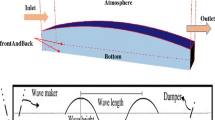Abstract
We have developed a three-dimensional BEM based code (3DYNAFS©) to study nonlinear free surface flows. The code is being used here to study bubble dynamics, such as that due to an underwater explosion, beneath surface piercing bodies. Six degree-of-freedom rigid body motion of the surface piercing bodies are modeled producing a fully coupled fluid-structure interaction effect simulation. Validation of the code is presented by comparison of simulations with laboratory experimental data obtained from high speed video recordings of surface piercing bodies interacting with bubbles generated by electric spark discharge. Two cylindrical body configurations are considered under both free floating and rigidly constrained conditions. The results of the numerical simulation show very good comparison to the experimental data in terms of bubble shapes and periods, the time evolution of the bubble and the induced motion of the bodies.
Similar content being viewed by others
Author information
Authors and Affiliations
Corresponding author
Additional information
This work was sponsored in part by the Office of Naval Research under Contract No. N00014-00-C-0344, monitored by Dr. Judah Goldwasser. The support of Mr. Gregory Harris from NSWC Indian Head is also greatly appreciated.
Rights and permissions
About this article
Cite this article
Chahine, G., Kalumuck, K. & Hsiao, CT. Simulation of surface piercing body coupled response to underwater bubble dynamics utilizing 3DYNAFS, a three-dimensional BEM code. Computational Mechanics 32, 319–326 (2003). https://doi.org/10.1007/s00466-003-0489-1
Issue Date:
DOI: https://doi.org/10.1007/s00466-003-0489-1



